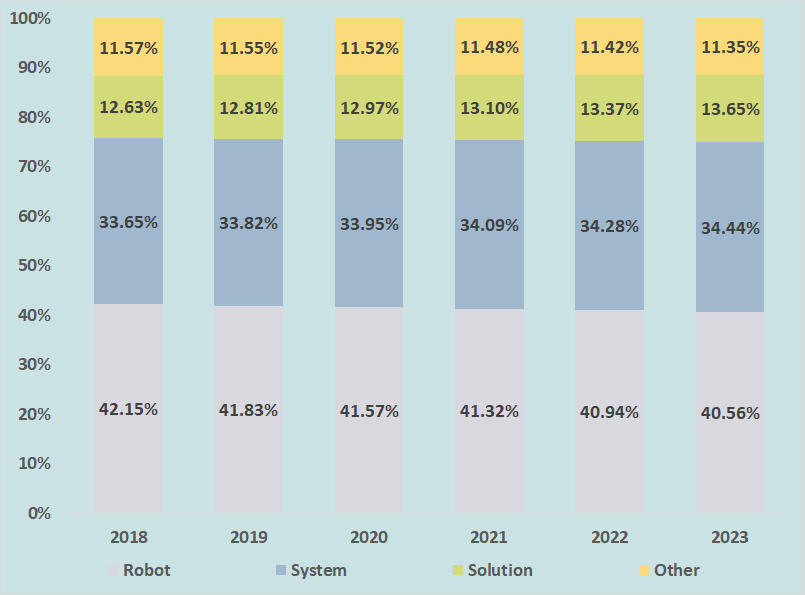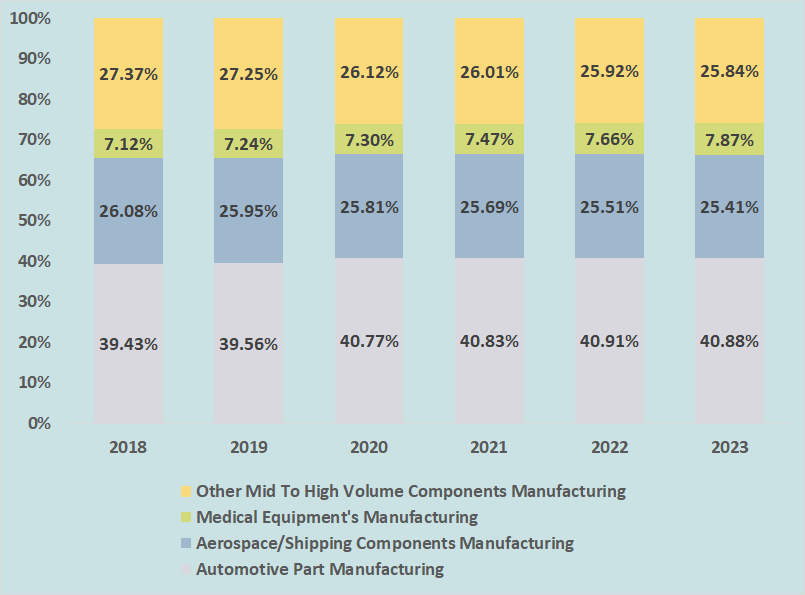1 Types of Machine Tools Automation
The machine tools automation market can be segmented into Robot, System, and Solution. Robots, also known as industrial robots, are pivotal in the machine tool automation market, designed to execute a broad spectrum of manufacturing tasks including material handling, moving, assembly, and machining processes. ‘System’ refers to the integration of diverse automation technologies like CNC machines, robotics, sensors, and software to form a cohesive unit that controls and refines manufacturing operations. Lastly, ‘Solution’ encompasses a variety of technologies and services aimed at automating production processes to enhance efficiency, productivity, and quality for manufacturers.
Table Different Types of Machine Tools Automation
Item | Description |
Robot | Machine tools automation robots, also known as industrial robots, are playing an increasingly important role in the machine tool automation market. These robots are designed to perform a wide range of manufacturing tasks, from handling and moving materials to performing complex assembly and machining processes. |
System | Machine tools automation systems refer to the integration of various automation technologies, such as computer numerical control (CNC) machines, robotics, sensors, and software, into a unified system for controlling and optimizing manufacturing processes. |
Solution | Machine tools automation solutions refer to a range of technologies and services that enable manufacturers to automate their production processes and improve efficiency, productivity, and quality. |
2 Applications of Machine Tools Automation
The machine tools automation market encompasses a variety of applications that are essential to numerous industries. These applications include automotive part manufacturing, aerospace/shipping components manufacturing, medical equipment’s manufacturing, and other mid to high volume components manufacturing.
Table Different Applications of Machine Tools Automation
Item | Description |
Automotive Part Manufacturing | In the automotive industry, machine tools automation is used for a range of tasks, including machining engine blocks, cylinder heads, transmission cases, and other components. Automation technologies such as CNC machines and robotics can help manufacturers achieve higher precision and consistency in their production processes, leading to improved quality and lower costs. Additionally, machine tools automation can help manufacturers respond to changes in demand more quickly and efficiently, allowing them to adapt to changing market conditions. |
Aerospace/Shipping Components Manufacturing | The aerospace and shipping industries require the production of large and complex components with tight tolerances. Machine tools automation is used to manufacture a range of components, including aircraft engine parts, landing gear, and ship propellers. Automation technologies can help manufacturers achieve higher precision and consistency in their production processes, leading to improved quality and reduced costs. |
Medical Equipment’s Manufacturing | Machine tools automation is used in the production of a range of medical equipment, including surgical instruments, implants, and diagnostic devices. Automation technologies can help manufacturers achieve the precision and accuracy required for these products, while also ensuring consistent quality and reliability. Additionally, machine tools automation can help manufacturers maintain strict quality control and compliance with regulatory requirements. |
Other Mid To High Volume Components Manufacturing | Machine tools automation is used in many other industries for the production of mid to high volume components. This includes industries such as consumer electronics, industrial equipment, and renewable energy. Automation technologies can help manufacturers achieve greater efficiency and productivity in their operations, while also improving quality and reducing costs. |
3 Global Machine Tools Automation Value by Type (2018-2031)
In 2023, the global machine tools automation market is valued at approximately 7.14 billion USD. The robot segment is the most significant contributor, with a value of around 2.89 billion USD. The system segment follows with a value of approximately 2.46 billion USD. The solution segment accounts for about 0.97 billion USD, while the ‘other’ category contributes around 0.81 billion USD to the total market value.
Looking ahead, the forecast from 2023 to 2031 shows a positive growth trend across all segments. By 2031, the total market value is projected to increase to approximately 13.97 billion USD. The robot segment is expected to lead the growth, reaching an estimated value of 5.30 billion USD. The system segment is also anticipated to grow substantially, with a projected value of about 4.99 billion USD. The solution segment and the ‘other’ category are forecasted to reach 2.14 billion USD and 1.54 billion USD, respectively, by 2031. This indicates a strong upward trajectory for the machine tools automation market, reflecting the increasing demand and adoption of automation technologies in various industries.
Table Global Machine Tools Automation Value (M USD) by Type (2018-2023)
| 2018 | 2019 | 2020 | 2021 | 2022 | 2023 |
Robot | 1965.39 | 2070.71 | 2218.58 | 2504.07 | 2680.68 | 2894.46 |
System | 1569.25 | 1674.44 | 1811.77 | 2065.94 | 2244.90 | 2457.57 |
Solution | 588.99 | 634.10 | 692.04 | 794.01 | 875.39 | 973.82 |
Other | 539.39 | 571.63 | 614.96 | 695.87 | 747.52 | 809.69 |
Total | 4663.02 | 4950.89 | 5337.36 | 6059.89 | 6548.49 | 7135.54 |
Table Global Machine Tools Automation Market Value (M USD) Forecast, by Type (2023-2031)
| 2023 | 2024 | 2025 | 2026 | 2027 | 2028 | 2029 | 2030 | 2031 |
Robot | 2894.46 | 3120.63 | 3386.06 | 3648.81 | 3903.73 | 4184.57 | 4513.42 | 4899.44 | 5301.44 |
System | 2457.57 | 2685.46 | 2944.64 | 3207.76 | 3487.22 | 3794.12 | 4151.34 | 4557.41 | 4988.74 |
Solution | 973.82 | 1073.67 | 1187.47 | 1301.58 | 1435.64 | 1587.25 | 1752.26 | 1940.29 | 2137.08 |
Other | 809.69 | 878.76 | 958.04 | 1035.66 | 1113.05 | 1198.21 | 1302.11 | 1421.27 | 1543.88 |
Total | 7135.54 | 7758.51 | 8476.20 | 9193.81 | 9939.64 | 10764.15 | 11719.12 | 12818.42 | 13971.15 |
4 Global Machine Tools Automation Value Share by Type (2018-2023)
The robot segment has shown a slight fluctuation in its market share over the years. It started at 42.15% in 2018, decreased to 41.83% in 2019, and then saw minor variations, ending at 40.56% in 2023. Followed by the System segment, it has maintained a relatively stable market share, beginning at 33.65% in 2018 and experiencing minor increases and decreases, closing at 34.44% in 2023. The market share for solutions has been gradually increasing. It began at 12.63% in 2018, showing a slight upward trend, and reached 13.65% by 2023.
Overall, the ‘Robot’ and ‘System’ segments dominate the market, the ‘Solution’ category is gaining ground, and the ‘Other’ category is experiencing a slight decline in its share of the market.
Figure Global Machine Tools Automation Value Share by Type (2018-2023)

5 Global Machine Tools Automation Consumption Value by Application (2018-2031)
In 2018, the total consumption value was 4.66 billion USD, dominated by the automotive part manufacturing sector at 1.84 billion USD. The aerospace/shipping components manufacturing followed at 1.2 billion USD, while medical equipment’s manufacturing and other mid to high volume components manufacturing accounted for 332.21 million USD and 1.28 billion USD, respectively.
By 2023, the total consumption value increased to 7.14 billion USD. The automotive part manufacturing sector continued to lead with a value of 2.92 billion USD, followed by aerospace/shipping components manufacturing at 1.81 billion USD. Medical equipment’s manufacturing and other mid to high volume components manufacturing also saw growth, reaching 561.65 million USD and 1.84 billion USD, respectively.
The forecast from 2023 to 2031 anticipates a significant growth across all sectors. By 2031, the total consumption value is projected to rise to 13.97 billion USD. The automotive part manufacturing is expected to reach 6.05 billion USD, aerospace/shipping components manufacturing to 3.41 billion USD, medical equipment’s manufacturing to 1.27 billion USD, and other mid to high volume components manufacturing to 3.24 billion USD. This data underscores the expanding reliance on machine tools automation across various industries and the potential for substantial market growth in the coming years.
Table Global Machine Tools Automation Consumption Value (M USD) by Application (2018-2023)
| 2018 | 2019 | 2020 | 2021 | 2022 | 2023 |
Automotive Part Manufacturing | 1838.52 | 1958.56 | 2176.20 | 2474.48 | 2679.12 | 2916.84 |
Aerospace/Shipping Components Manufacturing | 1216.16 | 1284.73 | 1377.39 | 1556.62 | 1670.43 | 1813.00 |
Medical Equipment’s Manufacturing | 332.21 | 358.52 | 389.71 | 452.55 | 501.79 | 561.65 |
Other Mid To High Volume Components Manufacturing | 1276.14 | 1349.08 | 1394.06 | 1576.24 | 1697.16 | 1844.04 |
Total | 4663.02 | 4950.89 | 5337.36 | 6059.89 | 6548.49 | 7135.54 |
Table Global Market Consumption Value (M USD) Forecast by Application (2023-2031)
| 2023 | 2024 | 2025 | 2026 | 2027 | 2028 | 2029 | 2030 | 2031 |
Automotive Part Manufacturing | 2916.84 | 3180.03 | 3570.85 | 3876.31 | 4195.54 | 4536.80 | 4949.46 | 5550.94 | 6051.02 |
Aerospace/Shipping Components Manufacturing | 1813.00 | 1961.35 | 2130.98 | 2300.71 | 2470.05 | 2664.40 | 2886.16 | 3139.51 | 3406.02 |
Medical Equipment’s Manufacturing | 561.65 | 620.73 | 683.77 | 758.56 | 841.48 | 936.08 | 1035.90 | 1142.46 | 1273.57 |
Other Mid To High Volume Components Manufacturing | 1844.04 | 1996.40 | 2090.60 | 2258.22 | 2432.57 | 2626.87 | 2847.59 | 2985.51 | 3240.54 |
Total | 7135.54 | 7758.51 | 8476.20 | 9193.81 | 9939.64 | 10764.15 | 11719.12 | 12818.42 | 13971.15 |
6 Global Machine Tools Automation Consumption Value Market Share by Application (2018-2023)
Automotive part manufacturing has consistently held the largest share, starting at 39.43% in 2018 and seeing a slight increase to 40.88% by 2023, indicating a significant reliance on automation in this sector. Aerospace/shipping components manufacturing has shown a gradual increase from 26.08% to 25.41% over the same period, reflecting the growing importance of automation in these industries. Medical equipment manufacturing has also seen a steady rise, from 7.12% to 7.87%, highlighting increased adoption of automation technologies. The ‘Other Mid To High Volume Components Manufacturing’ category has maintained a stable share, though it slightly decreased from 27.37% to 25.84%, encompassing various industries that utilize automation.
Overall, while the automotive part manufacturing sector dominates the market, there is a noticeable growth in the aerospace/shipping and medical equipment manufacturing sectors, indicating a diversifying demand for automation solutions across different industries. The “Other” category, though it has a smaller share compared to the leading sector, still plays a significant role in the total market.
Figure Global Machine Tools Automation Consumption Value Market Share by Application (2018-2023)






